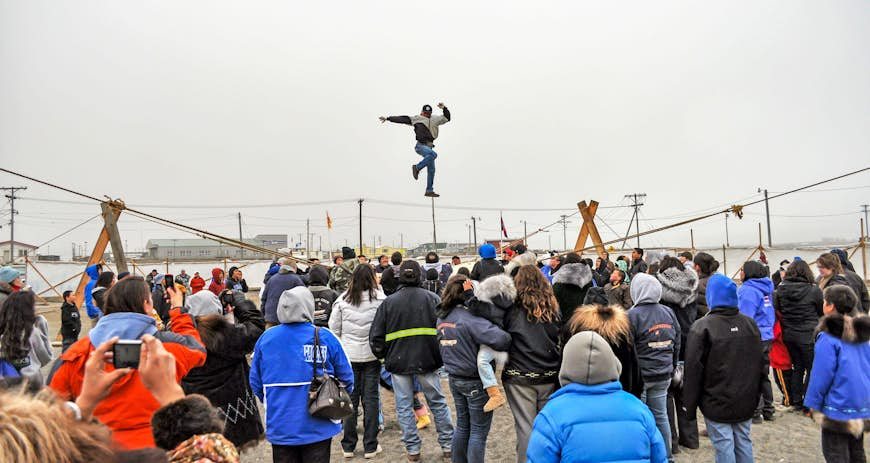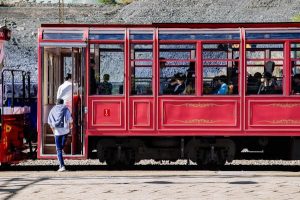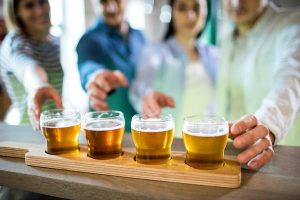
Although well-known for its snowy mountains, lush rain forests and incredible wildlife like bears, moose and humpback whales, Alaska is also rich in the cultures of Alaska Native peoples. Their worldviews, language, singing and dancing traditions, and ways of life have been shaped by these lands – and indeed shape how visitors experience them.
Travelers to Alaska will learn about the traditions that have sustained Alaska Natives for thousands of years. Get to know the true Alaska by grounding yourself in the modern ways Alaska Native peoples celebrate and practice their culture around the state.
 Head to Fairbanks, Alaska, for some of the most competitive dog mushing races © Youli Zhao / EyeEm / Getty Images
Head to Fairbanks, Alaska, for some of the most competitive dog mushing races © Youli Zhao / EyeEm / Getty Images
Explore dog mushing traditions
Fairbanks is the ancestral and unceded traditional territory of the lower Tanana Dene peoples. While many Alaska Natives live in the Fairbanks area, you will find the largest majority of Athabascan (Gwich’in, Koyukon, Lower Tanana and more) and Iñupiaq people represented here. Dog mushing is a tradition that was introduced to this region by Alaska Natives.
During the late winter and early springtime, many communities cheer for their favorites in the sprint dog races, like the three-day Open North American Championships in mid-March. Mushers and spectators alike eagerly watch sprint times, pick out their favorite teams and dogs and generally enjoy some much-needed daylight.
Forge new connections on your next adventure with the latest advice from our weekly newsletter.
Attend the Festival of Native Arts in Fairbanks
A little later in March, the Festival of Native Arts at the University of Alaska Fairbanks is where visitors can experience Alaska Native singing and dancing and learn about many rich cultures and storytelling. See performances from the Dena’ Intertribal Dancers, who perform Athabascan songs and dances while dressed in moosehide vests and dresses adorned with Athabascan beadwork. Usually, toward the end of the sets, dance groups will welcome individuals to practice the dances and feel the power of the drum for themselves.
Cheer on incredible survival skills at the World Eskimo-Indian Olympics
Dog mushing isn’t the only sport popular with Alaska Native people. In July, traditional Alaska Native sports are on display at the World Eskimo-Indian Olympics (WEIO). Games here showcase the skill and preparedness one needs for survival across the region, such as the fish-cutting contest or the two-foot high kick, in which athletes use both feet to kick a seal skin ball hanging from a rope. While definitely an Olympic-style competition with a mastery of agility and strength, camaraderie is part of the event: athletes cheer each other on and offer pointers to one another. You can also watch dance group performances, the Miss WEIO pageant and regalia contests.
Listen to Athabascan fiddling
More foot-stomping dancing and fiddle music happen later in the year with two key celebrations. More than 80 performers ranging from elders to youth musicians perform at the Athabascan Fiddlers Festival, when people from all over come to celebrate Athabascan culture, traditions and music. The Gwich’in Athabascan Fiddle Dance sometimes happens at about the same time in November with people dancing the jig, two-step and other dances. Many of the Gwich’in dance pros wear beautiful beaded moosehide mukluks and other regalia.
Admire interior Alaska Native cultural exhibits
A visit to the interior would not be complete without stopping by the Morris Thompson Cultural & Visitors Center, which features Alaska Native lifestyle exhibits, artwork like an archway made of moose and caribou antlers, as well as history from the interior. Be sure to take a moment to admire the innovative and beautiful beaded designs of Alaska Native artists. Fish skin processing has seen a resurgence in the past 20 years, and visitors will see salmon leather transformed into jewelry, bags and baskets, among many other unique creations.
 Nalukataq literally means “to be tossed up and down on a bearded sealskin blanket” © Rocky Grimes / Alamy Stock Photo
Nalukataq literally means “to be tossed up and down on a bearded sealskin blanket” © Rocky Grimes / Alamy Stock Photo
Celebrate with a blanket toss at Nalukataq
Travel up north to Utqiaġvik (formerly Barrow) in late June to experience Nalukataq, a celebration of the gift and spirit of the bowhead whale and the successful whaling crews that provide for their community. During Nalukataq, local Iñupiat whaling crews serve the entire community with various cuts of whale, locally prepared bread, caribou and goose soup, and other delicacies to sustain the community through the winter.
Nalukataq is not complete without a blanket-toss celebration and traditional dancing to cap off the day. Nalukataq literally means “to be tossed up and down on a bearded sealskin blanket.” People are tossed high into the air on this blanket, a tradition that originates from hunters who needed to spot game far off in the distance. Some Iñupiaq display their athleticism by doing flips and tricks in their traditional parkas. Another exciting part of the celebration is when they toss candy, to the kids’ delight.
Learn Native dance at the Yup’ik celebration in Western Alaska
Dance is central to many Alaska Native communities. It’s a way to pass along oral traditions, culture, language and survival lessons, and a time to celebrate. In Mamterilleq (the traditional Yup’ik name for Bethel), the Cama-i Dance Festival takes place in March. The three-day celebration of Native dance represents the Yup’ik tradition of winter gatherings (the name comes from the greeting “Cama-i!”). Yup’ik, Cup’ik and St. Lawrence Island Yupik dancers often wear bright floral qaspeqs (summer parkas), mukluks and beaded fur headdresses.
The songs often feature stories about seal hunting or historical events. This festival is also a good chance to pick up carved masks, jewelry and crafts at the vendor booths.
Join the festivities at Southeast Alaska’s Celebration
Every other year in early June, one of the largest gatherings of Southeast Alaska Native peoples is held to celebrate Tlingit, Haida and Tsimshian cultures. Celebration is a four-day festival that fills the streets of Juneau with Native people embracing their heritage while dressed in the traditional regalia of their clans.
Celebration also features traditional food, arts and cultural artistry. Juneau is located in the traditional homelands of the A’akw Kwáan and T’aaḵu Kwáan and has a lot to offer in arts and culture, including spruce and cedar weaving, Chilkat robe weaving, formline design artwork and totem poles.
 Nagsragmiut Inupiaq Eskimo Drummers of Anaktuvuk Pass perform at a Native Foundation event in Anchorage © Daniel H Bailey / Getty Images
Nagsragmiut Inupiaq Eskimo Drummers of Anaktuvuk Pass perform at a Native Foundation event in Anchorage © Daniel H Bailey / Getty Images
Discover Native history and traditions at the Alaska Native Heritage Center
Many visitors to Alaska find themselves in Anchorage, also known as Dena’ina ełnena, the traditional homeland of the Dena’ina people. The Alaska Native Heritage Center, one of the largest cultural institutions in the state, is a must-visit. See traditional Alaska Native homes, community gathering places and structures. Museum docents and guides describe what materials they are made of and which groups lived in each, and they share stories and artifacts that further explain how they lived.
Special events also focus on Alaska Native dance and storytelling, and an on-site movie theater puts on films covering traditions from kayaks to totem poles.



